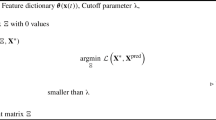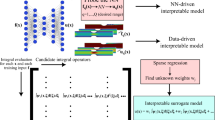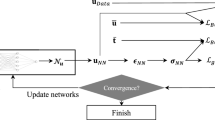Abstract
In many applied sciences, the main aim is to learn the parameters of parametric operators which best fit the observed data. Raissi et al. (J Comput Phys 348(1):683–693, 2017) provide an innovative method to resolve such problems by employing Gaussian process (GP) within a Bayesian framework. In this methodology, GP priors are modified based on the particular form of operators and are employed to infer hyperparameters by the maximum likelihood estimation (MLE). However, MLE-based and Bayesian inference usually involves setting up a covariance matrix that can be ill-conditioned. In this paper, the numerical stability of the methodology is investigated during training and prediction in two different assumptions: noisy and noise-free data. Based on the numerical simulations, for noisy data observations, by increasing noise in the data, the uncertainty in the predictions increases, and the accuracy of estimating the parameters decreases. However, the likelihood computation and model prediction will be significantly stable. While in the noise-free data observations, by increasing the number of data, the uncertainty quantification encoded in the posterior variances is significantly reduced, and the accuracy of the estimates is increased. But, the conditioning of the problem will be seriously distorted and we will face a very ill-condition problem. Therefore, in this paper, an approach is provided to manage the problem conditioning in the best possible way and consequently to improve the method performance in the noise-free data assumption using the hybrid kernels technique.



































Similar content being viewed by others
Data Availability
The datasets used for this study are partially available on request to the corresponding author.
References
Raissi M, Perdikaris P, Em Karniadakis G (2017) Machine learning of linear differential equations using Gaussian processes. J Comput Phys 348(1):683–693
Bender EA (1978) An introduction to mathematical modeling. Dover Publications Inc., Mineola
Bouhlel MA, Martins JRRA (2019) Gradient-enhanced kriging for high-dimensional problems. Eng Comput 35:157–173
Shao W, Deng H, Ma Y et al (2012) Extended Gaussian Kriging for computer experiments in engineering design. Eng Comput 28:161–178
Arthur CK, Temeng VA, Ziggah YY (2020) Novel approach to predicting blast-induced ground vibration using Gaussian process regression. Eng Comput 36:29–42
Narayan A, Yan L, Zhou T (2021) Optimal design for kernel interpolation: applications to uncertainty quantification. J Comput Phys 430:1–20
Qin T, Chen Z, Jakeman JD, Xiu D (2021) Deep learning of parameterized equations with applications to uncertanity quantification. Int J Uncert Quantif 11(2):63–82
Mueller JL, Siltanen S (2012) Linear and nonlinear inverse problems with practical applications, computational science and engineering, vol 10. SIAM, Philadelphia
Neto FDM (2013) An introduction to inverse problems with applications. Springer, Berlin
Dass SC, Lee J, Lee K et al (2017) Laplace based approximate posterior inference for differential equation models. Stat Comput 27:679–698
Williams CK, Rasmussen CE (2006) Gaussian processes for machine learning. The MIT Press, Cambridge
Murphy KP (2012) Machine learning: a probabilistic perspective. MIT Press, Cambridge
Raissi M, Perdikaris P, Em Karniadakis G (2018) Numerical Gaussian processes for time-dependent and nonlinear partial differential equations. SIAM J Sci Comput 40(1):172–198
Vapnik V (2013) The nature of statistical learning theory. Springer, New York
Cavoretto R, De Rossi A, Perracchione E (2023) Learning with partition of unity-based Kriging estimators. Appl Math Comput 448:127938
Tikhonov A (1963) Solution of incorrectly formulated problems and the regularization method. Soviet Math. Dokl. 5:1035–1038
Poggio T, Girosi F (1990) Networks for approximation and learning. Proc IEEE 78:1481–1497
Fasshauer GE (2007) Meshfree approximation methods with Matlab, interdisciplinary mathematical sciences, vol 6. World Scientific Publishing, Singapore
Fasshauer GE, McCourt M (2015) Kernel-based approximation methods using MATLAB, interdisciplinary mathematical sciences. World Scientific Publishing, Singapore
Kohn R, Ansley CF, Tharm D (1991) The performance of cross-validation and maximum likelihood estimators of spline smoothing parameters. J Am Stat Assoc 86(416):1042–1050
Sacks J, Welch WJ, Mitchell TJ, Wynn HP (1989) Design and Analysis of Computer Experiments. Stat Sci 4(4):409–435
Rasmussen CE, Ghahramani Z (2001) Occam’s razor. Adv Neural Inform Process Syst 294–300
Perkins TJ, Jaeger J, Reinitz J, Glass L (2006) Reverse engineering the gap gene network of Drosophila melanogaster. PLoS Comput Biol 2(5):e51
Alvarez MA, Luengo D, Lawrence ND (2023) Linear latent force models using Gaussian processes. IEEE Trans Pattern Anal Mach Intell 35(11):2693–2705
Poustelnikova E, Pisarev A, Blagov M, Samsonova M, Reinitz J (2004) A database for management of gene expression data in situ. Bioinformatics 20(14):2212–2221
Chatrabgoun O, Esmaeilbeigi M, Cheraghi M (2022) Stable likelihood computation for machine learning of linear differential operators with Gaussian processes. Int J Uncertain Quantif 12(3):75–99
Wendland H (2000) Scattered data approximation. Cambridge University Press, Cambridge
Esmaeilbeigi M, Chatrabgoun O, Daneshkhah A et al (2022) On the impact of prior distributions on efficiency of sparse Gaussian process regression. Eng Comput. https://doi.org/10.1007/s00366-022-01686-7
Hussain M (2021) Hybrid radial basis function methods of lines for the numerical solution of viscous Burgers’ equation. Comput Appl Math 40:107
Hussain M, Haq S (2020) A hybrid radial basis functions collocation technique to numerically solve fractional advection diffusion models. Numer Methods Partial Differ Equ 36:1254–1279
Mishra PK, Fasshauer GE, Sen MK, Ling L (2019) A stabilized radial basis-finite difference (RBF-FD) method with hybrid kernels. Comput Math Appl 77:2354–2368
Acknowledgements
The authors gratefully acknowledge the Iran National Science Foundation (INSF) for support of this work under project No. 99014278. The authors sincerely thank the two anonymous referees for their valuable comments and suggestions, which enabled to significantly improve the quality of this paper.
Author information
Authors and Affiliations
Corresponding author
Ethics declarations
Conflict of interest
The authors declare that they have no any competing interests.
Additional information
Publisher's Note
Springer Nature remains neutral with regard to jurisdictional claims in published maps and institutional affiliations.
Rights and permissions
Springer Nature or its licensor (e.g. a society or other partner) holds exclusive rights to this article under a publishing agreement with the author(s) or other rightsholder(s); author self-archiving of the accepted manuscript version of this article is solely governed by the terms of such publishing agreement and applicable law.
About this article
Cite this article
Esmaeilbeigi, M., Cheraghi, M. Hybrid kernel approach to improving the numerical stability of machine learning for parametric equations with Gaussian processes in the noisy and noise-free data assumptions. Engineering with Computers 40, 761–794 (2024). https://doi.org/10.1007/s00366-023-01818-7
Received:
Accepted:
Published:
Issue Date:
DOI: https://doi.org/10.1007/s00366-023-01818-7




